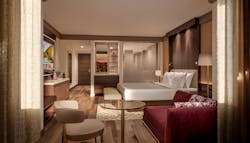Smart technology continues to be at the forefront of conversations, for hotel owners, customers, and designers alike, due to its ease-of-use for both guests and hotel staff and the possibilities it creates for an enhanced hotel experience.
Successful hotel design includes offering a series of touchpoints throughout the property that create memorable experiences at arrival and check-in, in guestrooms, food and beverage areas, meeting spaces, and amenities such as spas and fitness centers. The challenge becomes how to continue crafting those meaningful experiences while incorporating more and continually evolving technology into the various components of the hotel stay.
The evolution of keyless entry is a case and point. In a 30-year span, hotels have evolved from having metal keys to magstripe cards, RFID cards, or mobile keyless entry via cell phone. The latter transition appeals to those who use their cell phones for other online services such as banking, bill payment, text, email, and social media. Yet parts of the older generation are still catching up. With this in mind, many properties are taking a hybrid approach, offering both keypads and keyless entry options to their guests. Ultimately, the key will disappear altogether, resulting in less waste as plastic cards will no longer be needed. This is a direct effect of a technology that has environmental benefits. According to Booking.com’s Sustainable Travel Report 2022, 81% of global travelers said that traveling sustainably is important to them, with half citing climate change as a major influence on purchase choices.
Sustainability also continues to be a driving force in hospitality design, with trends often correlating with technological advances and how they can affect a property’s environmental footprint. While mobile technology provides new avenues for a greater guest experience and staff interaction, advanced technologies can also be incorporated to influence a hotel’s sustainable practices. This is appealing to a growing demographic of travelers. It is vital for hotels to implement more environmentally conscious processes into their services and operations and make these known to their customers. The travel industry is a major producer of emissions, so guests and hoteliers are looking for ways to minimize their carbon footprint and technology may just be one of the ways to aid in this effort. Sustainable design is at the forefront of conversations, and hotel owners and operators are listening. More and more properties are adopting a variety of sustainable practices such as installing solar panels, switching to energy-efficient lighting, tapping energy management systems, utilizing low-flow bathroom fixtures, or leveraging thermal heat pumps and modern wastewater treatment plants that will repurpose wastewater from sinks and showers for use in gardens. Some net-zero and low carbon solar-powered hotels are going all-in on renewable energy, with these properties producing at least as much energy as they consume. One example, featured on Lonely Planet, is the Svart Hotel in Meloy Norway, which will be the world's first energy positive hotel.
Technology Informs Design
The implementation of new technologies will inform how designers approach each project’s look and feel: from the hotel lobby, guestrooms, and restaurants to amenity spaces and business areas. While some properties have added tablets to their check-in areas for wireless access, or for food and beverage ordering, the ongoing trend to extend functionality to guest-owned devices is reducing the need for properties to provide their own technological devices, which run the risk of being damaged or stolen. The typical guest is familiar and comfortable with using their own device; catering to individualized wireless access can lead to a positive stay for the guest with a bonus of streamlining operations for the owner/operator. The smart technology approach will potentially reduce the number of check-in desks, allowing for a smaller footprint and more flexible lobby space, which can be transformed into additional meeting spaces or food and beverage opportunities. These trends will be vetted and ultimately decided on by ownership based on their customer demographic.
The use of mobile devices also has a variety of applications and benefits in terms of the in-room experience, making sure a guest’s preferences are top of mind. The customer’s device can be used to log into their favorite streaming platforms; the TV is set with their favorite networks and shows. On-site apps bring a sense of ease to guests: check-out can be an easy process via the mobile phone, room service can be ordered after perusing food and beverage menus on the screen, and reservations can be made with the touch of a few buttons.
For designers, the increased integration of mobile devices often necessitates the addition of easily accessible charging points. This can take form through wired decorative shelving adjacent to the TV monitor for plug-ins, nightstand charging stations, and electric access at the tables and desks located in the rooms. Accommodations for voice command-generated technology also need to be considered as the public embraces this next level of interconnectivity and these conveniences become more affordable and standardized. Additionally, future improvements and more affordable options in touchscreen technology will result in increased usage of touchscreens within guestrooms. As such, designers need to be savvy about ergonomic access to the in-room TV monitor, which has new potential beyond something to watch and should be able to accommodate a smart device that requires greater human interaction. It may no longer make sense for the traditional room credenza to be located directly below the TV. In many instances, it can move to the closet or in proximity to an open bathroom concept, creating an integrated dressing area with a convenient luggage bench.
Consumer behavior and demographic trends shape every decision that owner-architect-designer teams make. Working closely with property owners and operators to better understand their brand and what their guests expect is essential in determining the needs for a given space and where technology fits into the design scheme. The overall guest experience can be greatly enhanced by making technology with efficiency a priority for both travelers and staff. Hospitality design should incorporate these new tech tools and conveniences to ensure an elevated experience at the hotel that provides more opportunities to engage in what the hotel has to offer. The marriage of sustainable practices that appeal to the environmentally conscious guest and new mobile technology will attract the tech-savvy traveler and contribute to a thoughtful and efficient design experience.
About the Author
Rick Marencic
Rick Marencic is a design principal at JCJ Architecture. His experience in the practice of interior design spans more than 40 years and includes all phases of design from project conception through construction administration. His vision and focus on design excellence are demonstrated by his creativity and delivery of memorable designs that are tailored to each client’s identity and market.
Sign up for our eNewsletters
Get the latest news and updates



